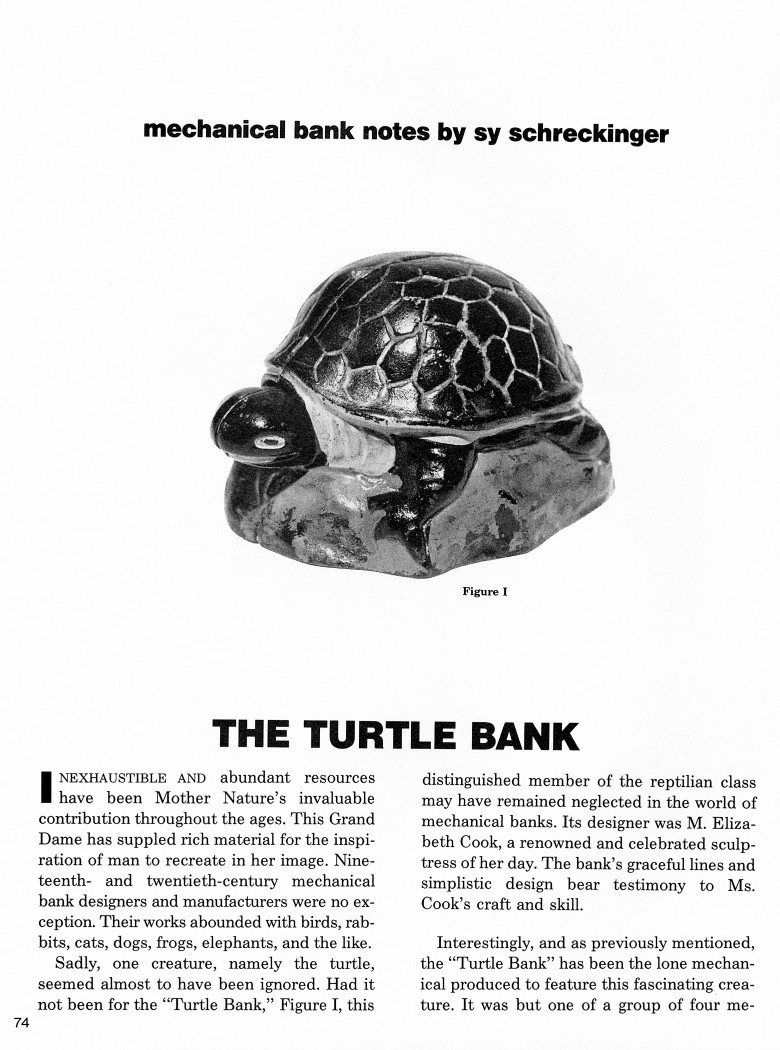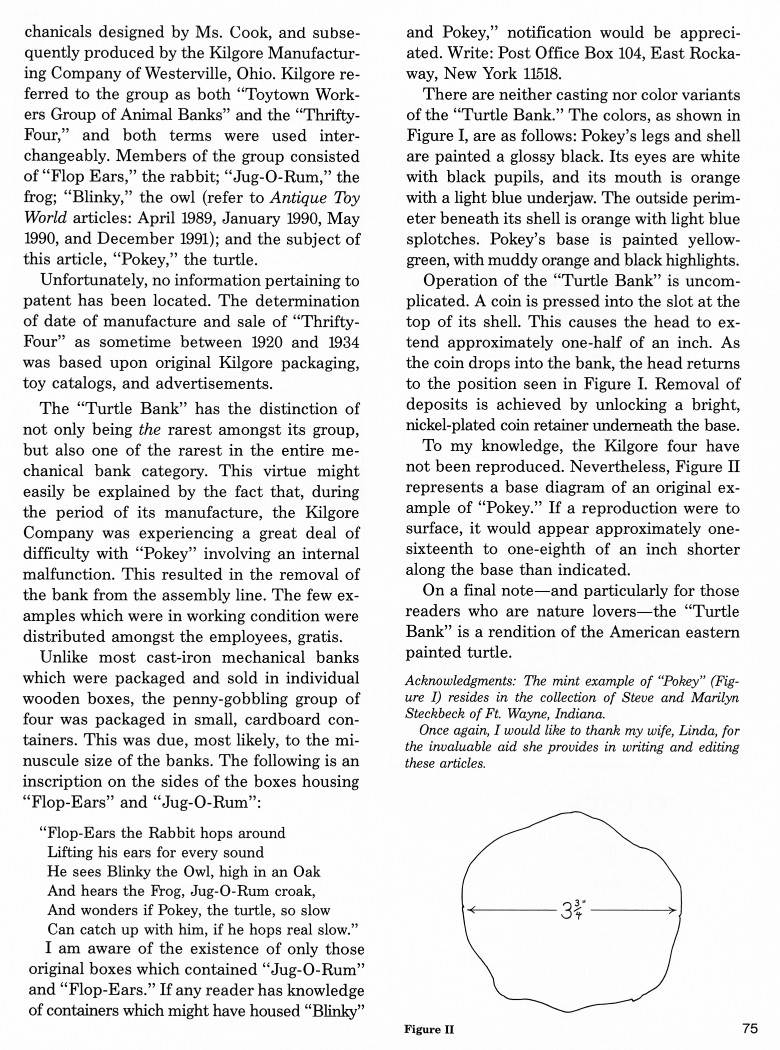|
The Turtle Bank
by Sy Schreckinger – ANTIQUE TOY WORLD Magazine – June, 1993
Inexhaustible and abundant resources have been
Mother Nature's invaluable contribution throughout the ages. This Grand
Dame has supplied rich material for the inspiration of man to recreate in
her image. Nineteenth and twentieth-century mechanical bank designers
and manufacturers were no exception. Their works abounded with birds,
rabbits, cats, dogs, frogs, elephants, and the like.
Sadly, one creature, namely the turtle, seemed almost to have been
ignored. Had it not been for the "Turtle Bank," Figure I, this
distinguished member of the reptilian class may have remained neglected in
the world of mechanical banks. Its designer was M. Elizabeth Cook, a
renowned and celebrated sculptress of her day. The bank's graceful lines
and simplistic design bear testimony to Ms. Cook's craft and skill.
Interestingly, and as previously mentioned, the "Turtle Bank" has
been the lone mechanical produced to feature this fascinating creature. It
was but one of a group of four mechanicals designed by Ms. Cook, and
subsequently produced by the Kilgore Manufacturing Company of Westerville,
Ohio. Kilgore referred to the group as both "Toytown Workers Group of
Animal Banks" and the "Thrifty-Four," and both terms were used
interchangeably. Members of the group consisted of "Flop Ears," the
rabbit; "Jug-O-Rum," the frog; "Blinky," the owl (refer to Antique Toy
World articles: April 1989,
January 1990,
May 1990, and
December 1991);
and the subject of this article, "Pokey," the turtle.
Unfortunately, no information pertaining to patent has been located.
The determination of date of manufacture and sale of "Thrifty-Four" as
sometime between 1920 and 1934 was based upon original Kilgore packaging,
toy catalogs, and advertisements.
The "Turtle Bank" has the distinction of not only being the rarest
amongst its group, but also one of the rarest in the entire mechanical
bank category. This virtue might easily be explained by the fact that,
during the period of its manufacture, the Kilgore Company was experiencing
a great deal of difficulty with "Pokey" involving an internal malfunction.
This resulted in the removal of the bank from the assembly line. The few
examples which were in working condition were distributed amongst the
employees, gratis.
Unlike most cast-iron mechanical banks which were packaged and sold
in individual wooden boxes, the penny-gobbling group of four was packaged
in small, cardboard containers. This was due, most likely, to the
minuscule size of the banks. The following is an inscription on the sides
of the boxes housing "Flop-Ears" and "Jug-O-Rum":
"Flop-Ears the Rabbit hops around
Lifting his ears for every sound
He sees Blinky the Owl, high in an Oak
And hears the Frog, Jug-O-Rum croak,
And wonders if Pokey, the turtle, so slow
Can catch up with him, if he hops real slow."
I am aware of the existence of only those original boxes which
contained "Jug-O-Rum" and "Flop-Ears." If any reader has knowledge of
containers which might have housed "Blinky" and "Pokey," notification would
be appreciated. Write: Post Office Box 104, East Rockaway, New York 11518.
There are neither casting nor color variants of the "Turtle Bank."
The colors, as shown in Figure I, are as follows: Pokey's legs and shell
are painted a glossy black. Its eyes are white with black pupils, and its
mouth is orange with a light blue underjaw. The outside perimeter beneath
its shell is orange with light blue splotches. Pokey's base is painted
yellow-green, with muddy orange and black highlights.
Operation of the "Turtle Bank" is uncomplicated. A coin is pressed
into the slot at the top of its shell. This causes the head to extend
approximately one-half of an inch. As the coin drops into the bank, the
head returns to the position seen in Figure I. Removal of deposits is
achieved by unlocking a bright, nickel-plated coin retainer underneath the
base.
To my knowledge, the Kilgore four have not been reproduced.
Nevertheless, Figure II represents a base diagram of an original example
of "Pokey." If a reproduction were to surface, it would appear
approximately one-sixteenth to one-eighth of an inch shorter along the
base than indicated.
On a final note — and particularly for those readers who are nature
lovers — the "Turtle Bank" is a rendition of the American eastern painted
turtle.
Acknowledgments: The mint example of "Pokey" (Figure I) resides in
the collection of Steve and Marilyn Steckbeck of Ft. Wayne, Indiana.
Once again, I would like to thank my wife, Linda, for the invaluable
aid she provides in writing and editing these articles.
|


